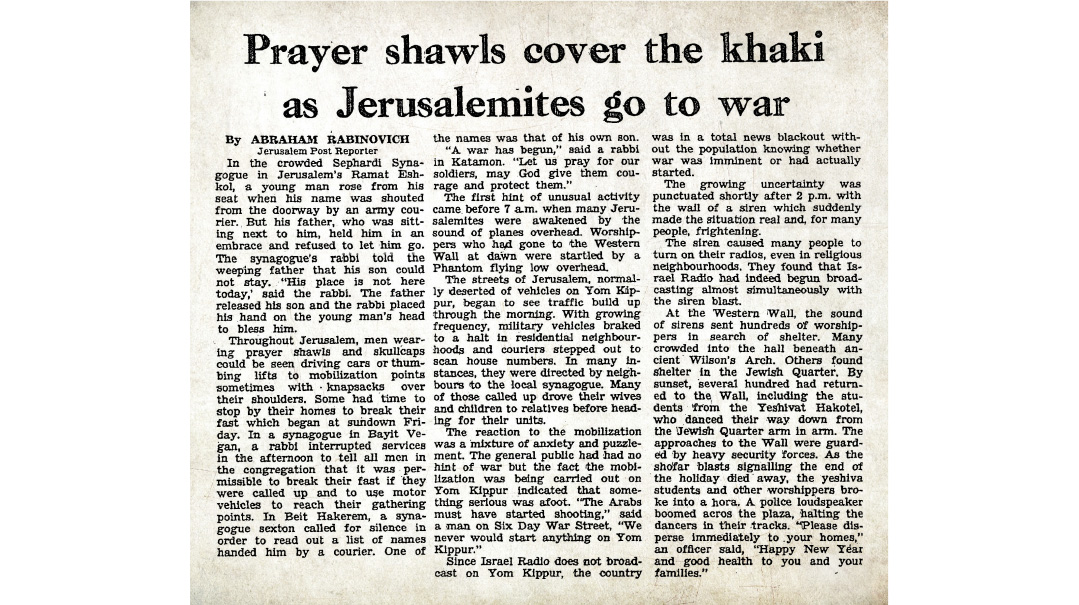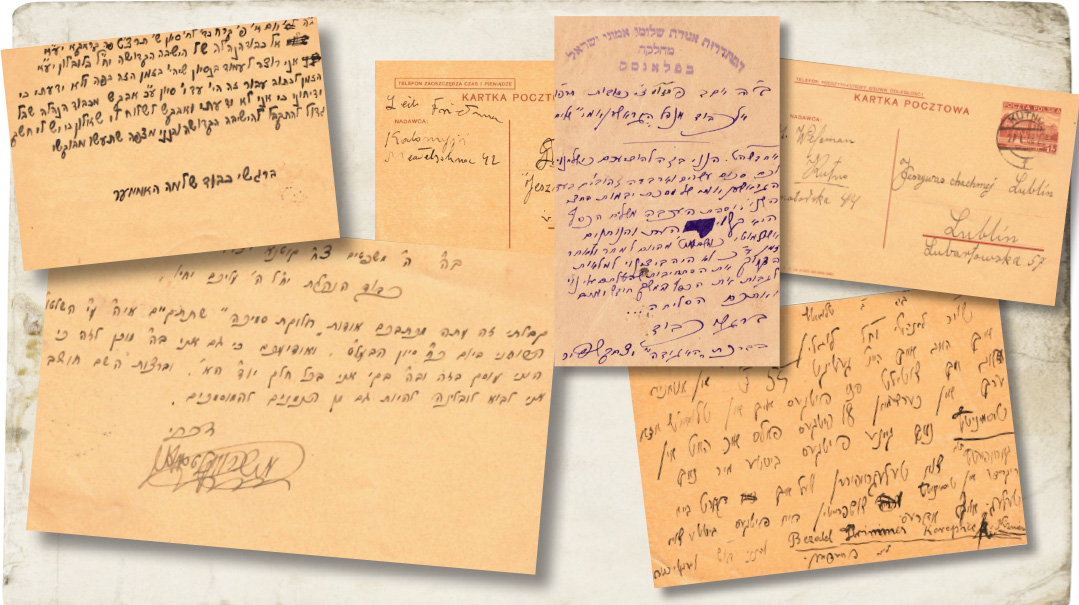At the Time of Ne’ilah
| September 19, 2023He began humming Kol Nidrei, and suddenly Purim had been transformed into Yom Hakippurim.…

Title: At the Time of Ne’ilah
Location: Sinai Desert and Golan Heights
Document: Jerusalem Post
Time: October 1973
War broke out on the afternoon of Yom Kippur. Many students were called to report to their units even before the fast ended, and they went to take leave of the roshei yeshivah. They left the yeshivah’s minyan and convened their own, completing Ne’ilah early. At the yeshivah’s main minyan, Rav Yehuda Amital gave an emotional speech before Ne’ilah.…
It was not long before terrible tidings began to arrive, one after the other. During the first twenty days of the war, Yeshivat Har Etzion lost eight of its students. Asher Yaron and Sariel Birnbaum, members of the yeshivah’s first class, were called up right after Yom Kippur and were killed the next day, in the holding defense battle against the Syrians on the Golan Heights. Birnbaum died still wearing his Yom Kippur clothes.…
Yoel Amital, who was called up on Simchas Torah, later asked his father how he felt and what he had to say about the loss of his eight students. Rav Amital sorrowfully answered his son: “What did [they] say in Slabodka after the events of 1929, when so many students of Yeshivas Chevron were killed? [They] cried.” …
The first Purim after the [Yom Kippur] war was charged with mixed feelings. The joy of the holiday was mixed with anguish over the war’s victims. A particularly emotional moment occurred on one of the nights before Purim, when all the rabbis and students sat together at a tish. Rav Amital told the students the well-known story of a Jew trying to remember the origins of a certain tune and whose searches led him ultimately to the tune of Kol Nidrei. “At the root of every tune we eventually reach Kol Nidrei.” He began humming Kol Nidrei, and suddenly Purim had been transformed into Yom Hakippurim.…
—By Faith Alone: The Story of Rav Yehuda Amital, by Elyashiv Reichner
Fought primarily on the Golan Heights and the Sinai Peninsula, the Yom Kippur War began exactly 50 years ago when the Egyptian and Syrian militaries launched a joint surprise attack on the afternoon of Yom Kippur 1973. The main fighting lasted nearly three weeks, October 6–25, and Israel sustained losses of nearly 3,000 combatants, mostly during the catastrophic early days of the conflict.
While Egyptian forces crossed the Suez Canal and overwhelmed the lightly defended Bar Lev Line, advancing through the Sinai, the Syrians inundated Israeli defenses in the southern Golan Heights, and there was concern that the Galilee would be endangered. The outnumbered Israeli tank units hastily mobilized and engaged the enemy on both fronts, but they soon ran low on ammunition and supplies. When the Soviet Union resupplied the Egyptians and Syrians, the United States felt compelled to resupply the Israeli military as well.
The tide soon turned on the Golan Heights. Israeli armored columns contained the Syrian advance, and then went on the offensive, advancing to within 30 kilometers of Damascus. Down in the Sinai, Israeli tanks pushed back the Egyptian advance and crossed the Suez Canal. Following intense fighting on both sides of the canal, IDF forces surrounded the Egyptian Third Army. A cease-fire went into effect on October 25, but fighting nevertheless continued in the ensuing months.
With the heavy loss of life and Israel’s near defeat in the early days of the conflict, the Yom Kippur War also carried the eerie feeling of commencing on the ultimate Judgment Day. Men in kittlach rushed from shul through empty streets to mobilization centers. Yom Kippur garb was exchanged for military fatigues as men were hastily dispatched to the all-too-near front. As the battles raged over the following days and weeks, the Yom Tov season rolled on, and soldiers in combat zones struggled to celebrate Succos and Simchas Torah while fending off the enemy.
“Throughout the entire war, the niggun of the Yom Kippur Vidui continuously played in my head,” one young soldier recalled. “We were whisked to battle while davening Minchah on Yom Kippur. Once Succos began, we sang Hallel together in our unit. In our heads was the niggun of ashamnu, bagadnu, while our mouths sang the words of Hallel. The two prayers mixed together in our battlefield experience.”
Some combatants recalled their weakness on Motzaei Yom Kippur, entering a war zone after having fasted the entire day. To others, it was surreal to have just recited the words of Unesaneh Tokef, mi yichyeh u’mi yamus, then witnessed comrades in arms falling before their eyes a few hours later.
Yom Kippur was soon followed by Succos, and some soldiers were able to exchange their rifles for lulavim and esrogim during lulls in the fighting. Though combat personnel were told explicitly that they were absolved from the mitzvah of succah while serving on tanks in the Sinai or the Golan, many attempted to create field succahs on all sorts of military vehicles.
A reporter for a military newspaper in the Sinai relayed in an October 12 dispatch, “Despite being engaged in bitter battles, civilian life isn’t forgotten. Right on the front, I noticed an improvised succah. It was a halftrack covered in branches, kosher l’mehadrin.”
Not all of these battlefield succahs were kosher l’mehadrin. Yet the desire to commemorate the joyous holiday under barrages of Egyptian artillery led to creative solutions.
Simchas Beis Hashoeivah in a Military Cemetery
IDF burial units had an unenvied task in the early days of the war, attending to the large number of dead. One night, after a burial unit had completed its grim duty, one soldier began reciting the 15 Shir Hamaalos of Tehillim. “Tonight is Chol Hamoed, and we must commemorate the Simchas Beis Hashoeivah,” he told his shocked friends.
Celebrating the Torah in the Sinai
Israeli armored columns and paratroop brigades sustained heavy losses during the Battle of the Chinese Farm in the Sinai. The troops were suffering from depleted manpower and low morale as the night of Simchas Torah loomed. That evening, a young man named Menashe Davidovitz began to sing hakafos niggunim among the sand dunes. Soon the soldiers joined hands in a dance, and the battalion’s chaplain arrived with a sefer Torah. The dancing grew lively in the desert battlefield, as Simchas Torah was celebrated in this most unlikely venue. With renewed confidence, they were deployed across the Suez Canal the next morning. Among the casualties in the fighting around Ismailia the next day was Menashe Davidovitz Hy”d.
(Originally featured in Mishpacha, Issue 979)
Oops! We could not locate your form.







